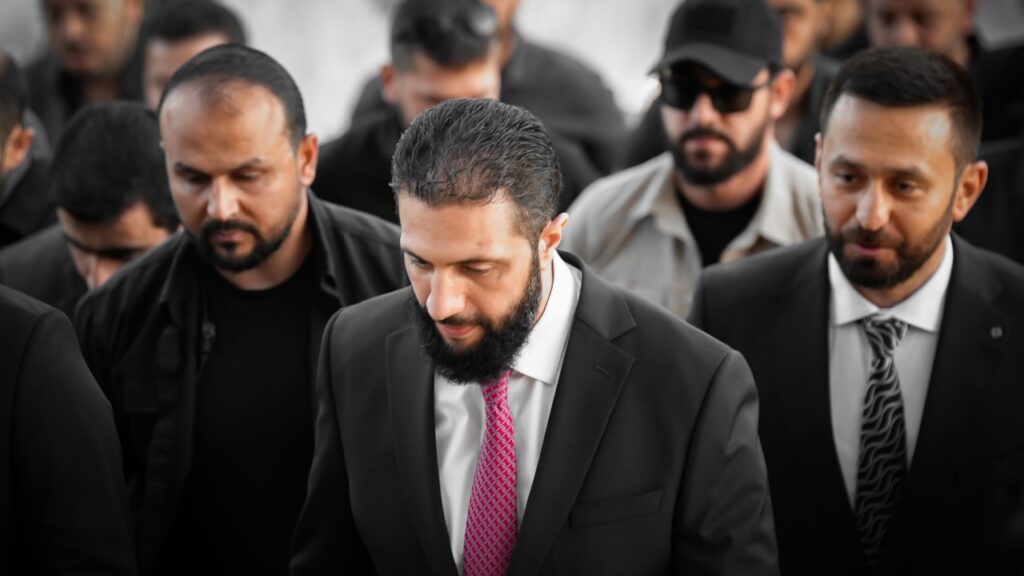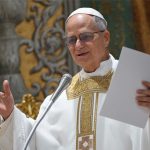Last week’s summit in Anchorage raised familiar, if still unanswered, questions about Donald Trump’s relationship with Vladimir Putin.
What more could a wanted war criminal ask for? The International Criminal Court has issued an arrest warrant on Vladimir Putin for alleged war crimes in Ukraine, and the 125 countries that are parties to the treaty that established the ICC (the United States is not one of them) are obligated to execute the warrant if given the opportunity. But now the president of the United States has not only hosted Putin on US soil but also done so in a manner more befitting a valued ally than a dictator who launched a war of aggression that so far has caused nearly 50,000 Ukrainian civilian casualties.
Donald Trump’s welcome of Putin in Anchorage featured a red carpet, an aircraft flyover, and warm smiles and applause from President Donald Trump. In a later joint appearance, the bonhomie continued, with Trump and his friend “Vladimir” showering praise on each other.
The summit meeting was a big win for Putin on multiple grounds, including exacerbating US-European differences on policy toward Russia. The mere scheduling of the meeting was enough for Kremlin-controlled media to boast, “Putin’s visit to the USA means the total collapse of the whole concept of isolating Russia. Total collapse.”
Trump has conferred a huge gift on Putin. Lurking behind that gift is the longstanding irregularity of Donald Trump’s relationship with Russia and the regime of Vladimir Putin. It is a relationship that has never been adequately investigated or widely acknowledged, and it is an essential context of any US-Russian dealings as long as Trump is in power.
My examination of this relationship in The National Interest has reviewed the multiple indications that Trump’s deference to Putin’s regime goes beyond what can be explained by Trump’s authoritarian envy and certainly beyond anything defensible in terms of US interests. Instead, the deference reflects some form of indebtedness or other ties that Trump has assiduously endeavored to hide. As described in the previous articles, the hiding has included Trump’s highly unusual tactic during his first term of excluding US officials from any knowledge of the substance of private conversations he had with Putin.
Although the full basis of Trump’s odd relationship with Moscow is unknown and may extend to commercial matters, the Russian regime’s help in getting Trump elected is surely part of it. The Russian interference in the 2016 presidential election has been affirmed and documented in an assessment by the US intelligence community, the report of special counsel Robert Mueller, and most extensively, a bipartisan report of the Senate Select Committee on Intelligence.
Ever since, Trump and his most devoted supporters have spared no effort in trying to discredit any mention, let alone any investigation, of Russia’s election help to Trump or of Trump’s relationship with Russia generally. Trump himself was at it again in his joint appearance with Putin in Anchorage, complaining that “we had to put up with the Russia, Russia, Russia hoax.” The primary motivation behind the discrediting evidently is to negate any impression that the foreign interference made Trump’s election victory appear less legitimate than it otherwise would be, as well as to preclude any potentially more scandalous revelations.
Recently, the campaign to discredit the allegations has shifted into overdrive. Perhaps anticipation of the summit meeting with Putin has had something to do with this, but the timing suggests that knocking the Jeffrey Epstein story off the front pages has been at least as much of a factor. Vociferous efforts to discredit actions taken under a Democratic administration also have been a way for an otherwise embattled Trump subordinate, such as Director of National Intelligence Tulsi Gabbard, to demonstrate her devotion to the leader and save her job.
The most recent rounds of discrediting have been scurrilous and extreme, including accusations of “treasonous” behavior by former public servants doing their jobs, and initiation of criminal proceedings against such former officials in the absence of any evidence of criminal conduct. The accusations also feature blatant falsehoods about what the supporting “evidence” supposedly states or what the targeted officials supposedly said.
For example, Gabbard’s attempt to portray intelligence officials under the Obama administration as perpetuating a false picture of Russian actions argues at length that there is no evidence that Russian cyberattacks compromised voting machines or other election infrastructure. But the intelligence agencies and their leaders never said there was. The Russian interference took other forms, such as trolling on social media and other methods of influencing public opinion.
Trump’s CIA director, John Ratcliffe, who has displayed ample evidence of his partisan motivations, declared that an internal lessons-learned review of the agency’s work on the Russian election interference showed that the analysis was conducted through a “corrupt process” in “politically charged environments” under former CIA director John Brennan and FBI director James Comey. However, although the review, like most such reviews, identified points for criticism, its most important finding—which Ratcliffe did not mention—was to confirm the original analysis’s judgments that Russia interfered in the election and did so partly to tilt the election in favor of Trump.
The recently declassified annex to the report issued by special counsel John Durham is another document touted by Trump defenders as supposedly showing corrupt, politically motivated work by the “deep state” on the Russian interference issue. Durham’s investigation itself constitutes one of the biggest refutations of that accusation. He was appointed by Trump’s first-term attorney general, William Barr, to try to find evidence that the investigations and analysis about Russian interference were politically motivated. After spending several years and millions of dollars on his inquiry, Durham failed to find any such evidence.
The biggest news that Durham had buried in the hitherto classified annex is—despite the touting by the Trump loyalists—that a supposed bombshell email showing that Hillary Clinton’s campaign had concocted the story of a Trump-Russia connection was most likely a Russian fabrication. It was one more example of Russian election interference, designed to discredit Clinton and help Trump.
The notion of a “Russia hoax” is itself a hoax. But due largely to the assiduous efforts of Trump and his loyalists to discredit anyone who has addressed the issue seriously, the hoax lives on.
Last week’s summit between Trump and Putin was originally scheduled to include, like some of their previous meetings, a private session with no other US officials present. This was later revised to include subordinates from both sides. However, the two presidents still had a private conversation after Trump invited Putin into the back seat of the presidential limousine. It is yet another conversation whose contents are likely to remain unknown to both US officials and the public.
As for Ukraine, Trump has long evinced his lack of support and empathy for this victim of Russian aggression, going back to Trump’s manipulation of security assistance to Ukraine to try to dig up dirt on his domestic political opponent, Joe Biden. Two days before Russia’s full-scale invasion of Ukraine in February 2022, Trump praised Putin as a “genius” who was making a “smart move” by sending a “peace force” to the Ukrainian border.
Since the two presidents left Anchorage, Trump has given additional signs of bowing to Putin’s obdurate posture about continuing the war. Trump is dropping any insistence on a ceasefire and seems more inclined to pressure Ukrainian president Volodymyr Zelensky than to pressure Putin.
Trump is dealing with Putin when the supporting staff of US officials has been partly purged of expertise on Russia and other relevant topics. The principal pre-summit session with Putin was conducted on the US side by Trump’s “special envoy for everything,” fellow real estate developer Steve Witkoff, who squeezed in the meeting between unrelated discussions on Gaza and Iran. In contrast, Putin can be assumed to have not only a supportive and experienced staff but also to have been confident in applying his old KGB skills to manipulate the flattery-prone Trump.
Trump, ever hungry for that elusive Nobel Peace Prize, is probably more anxious to claim credit for mediating an agreement on Ukraine than Putin is for reaching such an agreement. And as Trump has demonstrated in trade negotiations, what he claims to be an “agreement” is often a vague set of statements that other parties are free to interpret as they see fit.
But the biggest concerns about Donald Trump’s meeting with Putin in Alaska ought to be his motivations that may have less to do with US interests and facing up to aggression than they do with Trump’s strange personal relationship with Russia.
About the Author: Paul Pillar
Paul R. Pillar retired in 2005 from a twenty-eight-year career in the U.S. intelligence community, in which his last position was as the National Intelligence Officer for the Near East and South Asia. Earlier, he served in a variety of analytical and managerial positions, including as chief of analytic units at the CIA, covering portions of the Near East, the Persian Gulf, and South Asia. His most recent book is Beyond the Water’s Edge: How Partisanship Corrupts U.S. Foreign Policy. He is also a contributing editor for this publication.
Image: Joshua Sukoff / Shutterstock.com.
















